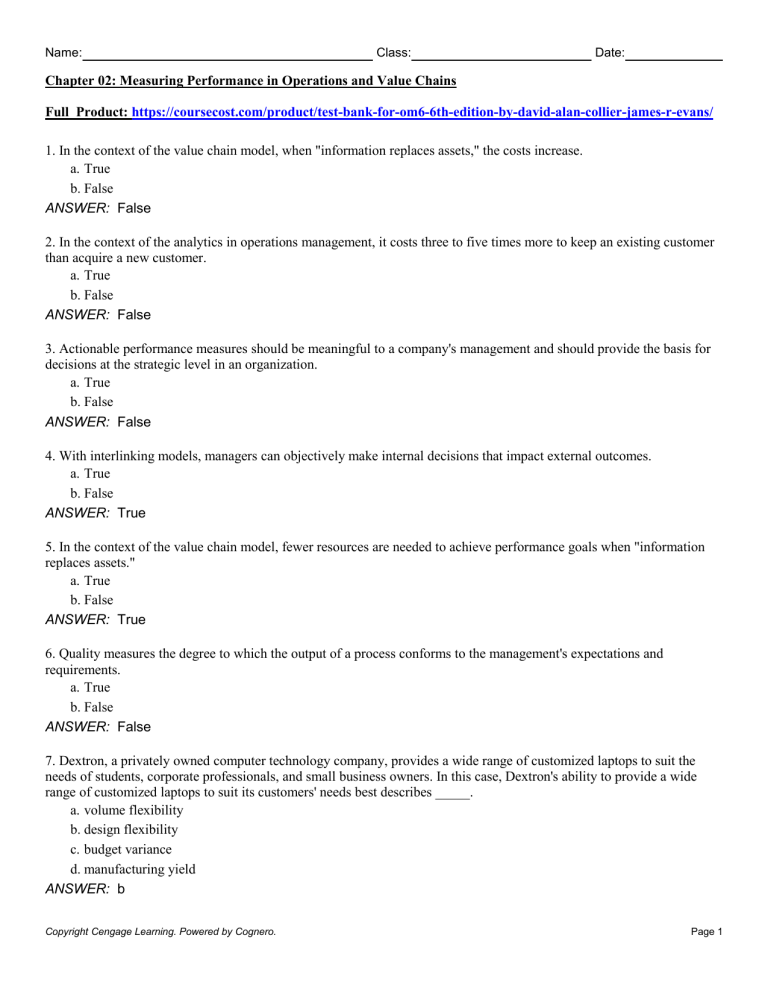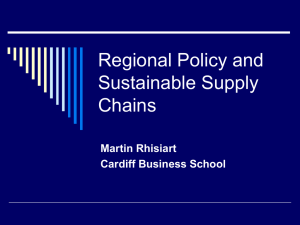
Name:
Class:
Date:
Chapter 02: Measuring Performance in Operations and Value Chains
Full Product: https://coursecost.com/product/test-bank-for-om6-6th-edition-by-david-alan-collier-james-r-evans/
1. In the context of the value chain model, when "information replaces assets," the costs increase.
a. True
b. False
ANSWER: False
2. In the context of the analytics in operations management, it costs three to five times more to keep an existing customer
than acquire a new customer.
a. True
b. False
ANSWER: False
3. Actionable performance measures should be meaningful to a company's management and should provide the basis for
decisions at the strategic level in an organization.
a. True
b. False
ANSWER: False
4. With interlinking models, managers can objectively make internal decisions that impact external outcomes.
a. True
b. False
ANSWER: True
5. In the context of the value chain model, fewer resources are needed to achieve performance goals when "information
replaces assets."
a. True
b. False
ANSWER: True
6. Quality measures the degree to which the output of a process conforms to the management's expectations and
requirements.
a. True
b. False
ANSWER: False
7. Dextron, a privately owned computer technology company, provides a wide range of customized laptops to suit the
needs of students, corporate professionals, and small business owners. In this case, Dextron's ability to provide a wide
range of customized laptops to suit its customers' needs best describes _____.
a. volume flexibility
b. design flexibility
c. budget variance
d. manufacturing yield
ANSWER: b
Copyright Cengage Learning. Powered by Cognero.
Page 1
Name:
Class:
Date:
Chapter 02: Measuring Performance in Operations and Value Chains
Full Product: https://coursecost.com/product/test-bank-for-om6-6th-edition-by-david-alan-collier-james-r-evans/
8. _____ is the ability to provide goods and services to customers with minimum waste and maximum utilization of
resources.
a. Operational efficiency
b. Volume flexibility
c. Reliability
d. Sustainability
ANSWER: a
9. Key measures of innovation and learning include__________.
a. supply-chain performance
b. processing time
c. percentage of new products developed
d. the variance around the average time
ANSWER: c
10. _____ is the act of quantifying the performance of organizational units, goods and services, processes, people, and
other business activities.
a. Measurement
b. Forecasting
c. Fulfillment
d. Litigating
ANSWER: a
11. The table below shows the data for the number of pair of shoes produced and the cost incurred by Fancy Trends Inc.
for the year 2015.?
Pair of Shoes Produced
150,000
Cost Incurred
Direct Labor Cost
$60,000
Energy Cost
$5,800
Raw Material Cost
$42,000
Based on the given data, the productivity of Fancy Trends Inc. for the year 2015 is _____.
a. 1 pair/USD
b. 1.39 pairs/USD
c. 2 pairs/USD
d. 2.46 pairs/USD
ANSWER: b
12. In the context of the types of performance measures, which of the following is a measure of innovation and learning?
a. Patent applications
b. Employee retention
c. Product recalls
d. Labor productivity
ANSWER: a
Copyright Cengage Learning. Powered by Cognero.
Page 2
Name:
Class:
Date:
Chapter 02: Measuring Performance in Operations and Value Chains
Full Product: https://coursecost.com/product/test-bank-for-om6-6th-edition-by-david-alan-collier-james-r-evans/
13. In the context of the triple bottom line,__________measures include corporate ethics and governance.
a. environmental sustainability
b. social sustainability
c. economic sustainability
d. political sustainability
ANSWER: b
14. Which of the following is a quality performance measure at an operational level?
a. Customer ratings of goods and services
b. Customer retention
c. Service representative courtesy
d. Product recalls
ANSWER: c
15. In the context of the triple bottom line (TBL), which of the following measures includes the number of ethical
violations?
a. Responsiveness
b. Service quality
c. Social sustainability
d. Customer retention rate
ANSWER: c
16. In the context of the scope of business and operations performance measurement, which of the following measures is
an example of an innovation and learning performance measure?
a. Employee satisfaction
b. Flow processing or cycle time
c. Manufacturing yield
d. Product-related litigation
ANSWER: a
17. _____ measures the degree to which the output of a process meets customer requirements.
a. Learning
b. Innovation
c. Variability
d. Quality
ANSWER: d
18. _____ include environmental measures such as energy consumption and recycling and other resource conservation
activities.
a. Operation efficiency measures
b. Innovation and learning measures
c. Sustainability measures
Copyright Cengage Learning. Powered by Cognero.
Page 3
Name:
Class:
Date:
Chapter 02: Measuring Performance in Operations and Value Chains
Full Product: https://coursecost.com/product/test-bank-for-om6-6th-edition-by-david-alan-collier-james-r-evans/
d. Financial measures
ANSWER: c
19. According to research, which of the following is a key dimension that customers use to assess service quality?
a. Operational efficiency
b. Flexibility
c. Empathy
d. Queue time
ANSWER: c
20. A paint manufacturing company has three factories located in France, Germany, and Spain. The productivity data of
the factories are as follows:
Factory Location
Amount of Paint Produced(US Gallons) Total Input Cost (USD)
Spain
4,600,000,000
$5,250,000
Germany
5,500,000,000
$5,250,000
France
4,000,000,000
$3,500,000
Based on the productivity analysis of all the factories, the productivity of the factory in:
a. Germany is lower than that of the factory in Spain.
b. Spain is higher than that of the factory in France.
c. France is higher than that of the factory in Spain.
d. France is lower than that of the factory in Germany.
ANSWER: c
21. Which of the following performance perspectives in the balanced scorecard model includes measures such as
productivity, flow time, and asset utilization?
a. The financial perspective
b. The customer perspective
c. The innovation and learning perspective
d. The internal perspective
ANSWER: d
22. Measures of__________focus on an organization's people and infrastructure.
a. goods and service design flexibility
b. customer and market
c. service quality
d. innovation and learning
ANSWER: d
23. Which of the following performance perspectives in the balanced scorecard model measures the ultimate value that a
business provides to its shareholders?
a. The financial perspective
b. The internal perspective
Copyright Cengage Learning. Powered by Cognero.
Page 4
Name:
Class:
Date:
Chapter 02: Measuring Performance in Operations and Value Chains
Full Product: https://coursecost.com/product/test-bank-for-om6-6th-edition-by-david-alan-collier-james-r-evans/
c. The learning perspective
d. The customer perspective
ANSWER: a
24. The innovation and learning perspective in the balanced scorecard model includes measures such as:
a. return on investment, economic value added, and shareholder value.
b. number of cooperative customer–company design initiatives and percent of sale from new services.
c. training hours per employee, hiring process effectiveness, and revenue per employee.
d. service-quality levels, design and demand flexibility, and asset utilization.
ANSWER: c
25. _____ is the ratio of the output of a process to the input.
a. Productivity
b. Flexibility
c. Variability
d. Reliability
ANSWER: a
26. __________is the willingness to help customers and provide prompt recovery to service upsets.
a. Responsiveness
b. Empathy
c. Assurance
d. Reliability
ANSWER: a
27. The__________is based on a set of cause-and-effect linkages between internal and external performance, and in this
fashion, defines the key performance measurements on which service-based firms should focus.
a. Service-Profit Chain model
b. value chain model
c. balanced scorecard
d. Malcolm Baldrige Performance Excellence program
ANSWER: a
28. The time required to ramp up to an increased production output level in response to a surge in the sales of a product is
a measure of _____.
a. budget variance
b. volume flexibility
c. product recalls
d. service upset
ANSWER: b
29. Airline revenue per passenger mile and hotel revenue per full-time employee are examples of _____.
Copyright Cengage Learning. Powered by Cognero.
Page 5
Name:
Class:
Date:
Chapter 02: Measuring Performance in Operations and Value Chains
Full Product: https://coursecost.com/product/test-bank-for-om6-6th-edition-by-david-alan-collier-james-r-evans/
a. reliability measures
b. flexibility measures
c. sustainability measures
d. productivity measures
ANSWER: d
30. Which of the following is a financial performance measure at an organizational level?
a. Cost of quality
b. Revenue and profit
c. Budget variance
d. Labor and material costs
ANSWER: b
31. In the context of the triple bottom line (TBL), which of the following is a performance measure of economic
sustainability?
a. Fines for environmental violations
b. Corporate ethics and governance
c. Revenue from new goods and services
d. Measures of perceived value
ANSWER: a
32. In an assembly line of a factory that makes gears, it takes fifteen minutes to complete a drilling operation using a lathe.
The duration of this operation is called _____.
a. delay time
b. queue time
c. processing time
d. standard time
ANSWER: c
33. The quantitative modeling of cause-and-effect relationships between external and internal performance criteria is
called__________.
a. productivity
b. operational efficiency
c. interlinking
d. sustainability
ANSWER: c
34. Which of the following performance perspectives in the balanced scorecard model includes the percent of sale from
new goods and services?
a. The financial perspective
b. The innovation perspective
c. The learning perspective
Copyright Cengage Learning. Powered by Cognero.
Page 6
Name:
Class:
Date:
Chapter 02: Measuring Performance in Operations and Value Chains
Full Product: https://coursecost.com/product/test-bank-for-om6-6th-edition-by-david-alan-collier-james-r-evans/
d. The customer perspective
ANSWER: d
35. The ability of an organization to respond quickly to changes in the quantity and type of demand is called _____.
a. utility
b. reliability
c. demand variability
d. volume flexibility
ANSWER: d
Copyright Cengage Learning. Powered by Cognero.
Page 7




